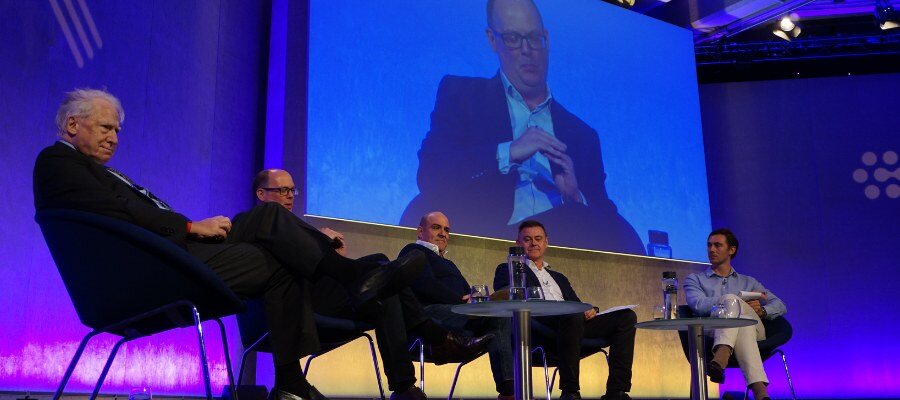/GX%20SUMMIT%20FT.jpg)
The ever-evolving C-suite: overview
- From 20th century geek to 21st century leader
- Skills of today's CIO: communication, comprehension, curiosity and conducting
- Designing the best teams and structures
Discover the evolving role of the CIO in today's business landscape from a GX Summit 2024 panel. Industry leaders discuss the crucial skills and strategies needed for CIOs to lead digital transformation and innovation.
This article is a write-up of ‘The Ever-Evolving C-Suite and the CIO’, a panel hosted at GX Summit 2024, in London, featuring:
HotTopics’ Editor Peter Stojanovic in conversation with Colin Lees, CTO, Gamma; Paul Coby, CIO, Persimmon Homes (former CIO British Airways and John Lewis); Ian Cohen, Group Technology Officer, Acacium Group (former CIO Addison Lee and FT); and Ian Golding, Interim Global CIO (former CIO Natural History Museum and RNLI).
View the full panel for 'The Ever-Evolving C-Suite and the CIO' below:
From 20th century geek to 21st century leader
The office of the CIO has seen immense change. Originally focused on managing IT infrastructure and ensuring the smooth operation of data processing systems, the technology team’s responsibilities have significantly expanded and transformed. Not for nothing is the modern day business a technology firm: the world has digitised to such an extent that both the economy and society use it to communicate, collaborate, socialise, plan, pay, partner, even vote. The strategic importance of technology to the business cannot be overstated. That makes the rise of the CIO understandable, but no less impressive.
Today, CIOs—and their similarly adept reports and peers, CISOs, CTOs, CDOs—drive innovation, digital transformation and business agility. They work closely with other C-suite executives to align IT initiatives with the aims of the CEO, leverage new and emerging technologies to create competitive advantages, and build a future workforce that will continue a momentum of innovation.
Modern technology teams reflect a modern-day diversity: comprising experts in cybersecurity, data analytics, cloud computing, digital strategy, product and service design. They are also expected to collaborate across departments to foster innovation, enhance customer experiences, uptick operational efficiency, and, critically, improve the bottom line.
The world has seen immense change, too. The business environment of today demands a digitally-enabled, leaner, nimbler organisation. What does that mean for a more powerful CIO and their business-critical teams?

Skills of today’s CIO: Communication, comprehension, curiosity and conducting
With such a wealth of experience on the panel—CIOs of a host of household names between them—few groups could be better placed to consider the necessary skills of the modern-day CIO. Between them, they came up with four Cs: communication, comprehension, curiosity and conducting.
“Leadership is the most important attribute of a CIO, of any C-suite member,” said Ian Cohen. “And what every leader does is bring simplicity to an area of complexity. This is especially true with the technology function and has never been more important given the increasing complexity of the technology landscape.”
Communication is core to turning the complex, simple. Colin Lees of Gamma went a step further by putting forward comprehension. “CIOs need to speak the language of the business and understand [the technology function].”
These two languages require translation and for Colin the CIO is best placed to achieve this comprehension between technologists and the rest of the business. Curiosity fed into Ian Golding’s answer, and throughout the panel discussion, as a component of every leader’s arsenal, whilst Paul Coby, widely seen as the UK’s most experienced CIO, reflected on his long career, finally settling on the complementary position of conductor.
Multiple voices, instruments, speeds and soloists (Paul’s words) can all be metaphors for how a CIO views their entire teams, on-premise or on cloud, regional or international, full-time or interim. Bringing them altogether is one thing, ensuring they all play from the same music sheet is another. The CIOs responsibility is to design an organisational structure that allows for that to happen.
Designing the best teams and structures
“Design, build and operate.” Paul segued into his failsafe three-star structure that builds a successful technology team. It also reflects Ian Cohen’s view on simplicity: overly complex structures yield cumbersome working relationships.
The best teams also benefit from a North Star, according to Ian Golding. A clear aim or mission statement focuses a team time and time again. As a well-known Interim CIO, Ian tries to ensure this is agreed upon as soon as he joins a new organisation. Past companies include the RNLI, a charity whose mission is to save lives. As he says, that is incredibly impactful. For others where the mission may be more abstract, senior leaders need to do better to communicate what it is, otherwise leaders experience what Ian called a “digital discord”.
That can be avoided by bringing technology closer to the business, Colin reiterated. He finds given direct reports the ability to be CIOs of distinct parts of the business a useful way giving them experience, but also ensuring they are closer to the solutions being built.
The acid test to see if that is working: Are you part of the business conversation?
The panel was unanimous about the need for the CIO and the wider team to be involved in strategy meetings and days away. If not, CIOs are not taken seriously—or, the role of digital technologies in the future of the business is not taken seriously.
Let’s say CIOs are taken seriously (and for nearly all companies now, that is the case), what do they require of their teams and of their future CIOs? Perhaps surprisingly, two answers came readily: an insatiable curiosity, as Ian Cohen explained, for everything, not just technology, and a ready willingness to help the business, said Colin.
“How can I help?”, may be the most powerful phrase a technology employee and future leader can utter in their career.
SUBMIT A COMMENT
RELATED ARTICLES
Join the community
To join the HotTopics Community and gain access to our exclusive content, events and networking opportunities simply fill in the form below.
